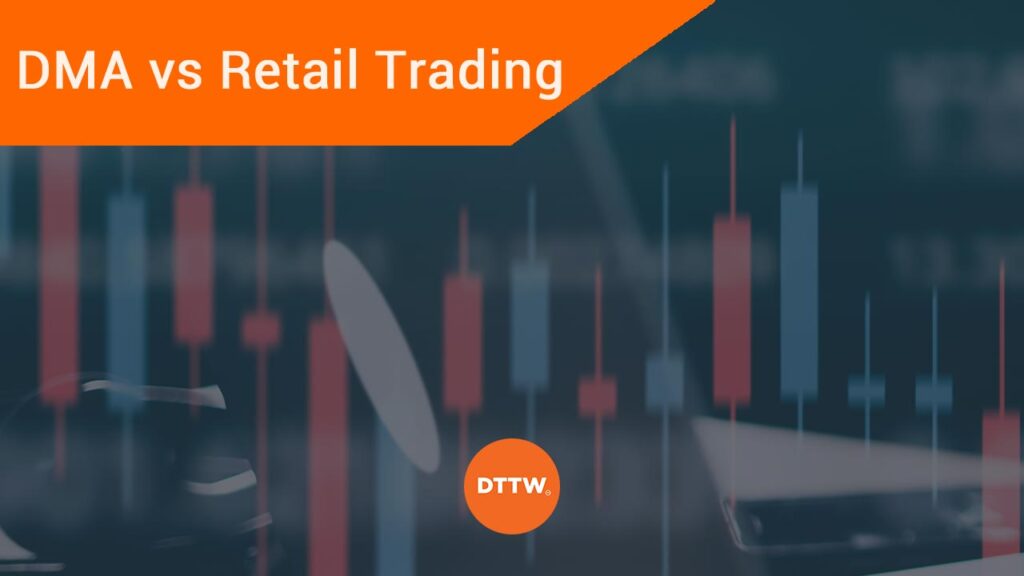Day trading has become an exciting career for millions of people in America. Furthermore, stocks have been relatively volatile recently because of the effects of the coronavirus pandemic. Most of these traders are using the popular trading platforms like Robinhood and Schwab.
In this article, we will look at the concept of Direct Market Access (DMA) and its key differences with retail traders.
What is Direct Market Access?
Direct Market Access is a trading approach where traders have direct access to the market. As such, their orders are implemented directly through their preferred gateway. Retail trades, on the other hand, are filled through intermediaries.
In early 2021, during the Wall Street Bets craze, the contrast between DMA and retail trading became clear. As stocks like AMC Entertainment and GameStop skyrocketed, retail brokerage companies were accused of colluding with their market makers like Citadel Securities.
For starters, while Robinhood is a good broker that offers free unlimited trades, there are concerns about how it makes money. It does this through what is known as payment for order flow (POF). This simply means that it routes all its trades through high frequency traders (HFT) like Citadel Securities.
In the past, these HFT companies have been accused of betting against retail traders.
In the United States, most of the popular retail trading companies like Robinhood and Schwab don’t offer direct market access. That’s because of two main reasons.
First, the companies make a substantial amount of revenue from order flow payments. Second, Schwab and other large brokerages tend to focus on long-term investors, who don’t have any issue with differences in small movements in prices.
How Direct Market Access works
The US has two main exchanges where companies are listed. These are the New York Stock Exchange (NYSE) and the Nasdaq. The exchanges make money directly from the companies they have listed. Another substantial source of revenue is from broker-dealers and liquidity providers.
These are companies that match buyers and sellers of shares in the market. The best-known of these companies are Bat Exchange, EDGX, AMEX, and ARB among others. As such, when using the popular retail trading brokers, you don’t have a say on where your orders are filled. At times, you might not get the best price.
In direct market access, you have access to these market makers and you can select the one with the best price. Because of how competitive it is, some of the market makers could also pay you some money for adding liquidity into their platforms.
Examples of brokers with direct market access
Fortunately, there are many brokers in the United States and around the world that offer DMA to their customers. Among the most popular ones are:
- Real Trading – Our company is not a broker. Instead, we are a prop firm that provides traders around the world an opportunity to make money. Our trading platform has a direct market access capabilities.
- Lightspeed – This is a company owned by Wedbush Securities, a well-known company in the United States.
- Interactive Brokers – This is a publicly traded broker that is valued at more than $31 billion. It has millions of customers from around the world.
- Speedtrader pro – The pro version of Speedtrader offers you more features like DMA and advanced level 2.
Benefits of using a direct market access broker
Better pricing
If you are a long-term investor, you can use any type of broker because your trade will be executed near the range where you want. For example, if Apple shares are trading at $130, you can be sure that it will be executed near that range. Therefore, it won’t make a significant difference since your plan is to hold it for a long time.
However, if you are a day trader, every penny counts and you want the best execution price. Using a broker that provides direct access to the market will help you determine the best route to execute your orders.
Advanced level 2
Level 2 is a dashboard that shows you the state of order flow in the market. It shows you the best bid and ask prices for most assets. In recent years, Robinhood has introduced Robinhood Gold, which provides the Level 2 data.
However, a closer look at Robinhood’s explanation shows you why it has its limitations. It says:
“Only orders from market participants directly on the Nasdaq stock market will appear on the Level II chart, so Level II Market Data may not include data on orders from other stock markets, trading venues, brokers, or Robinhood.”
» Related: Retail Trading vs Proprietary Trading Accounts
Further, Robinhood does not offer Level 2 quotes for free. It charges a fee through what is known as Robinhood Gold. The same is true with Schwab, which charges a fee for this data.
Therefore, at Real Trading, you get these advanced level 2 dashboards for free. Also, you get quotes from many market makers.
Speed and efficiency
Finally, direct market access helps to ensure that your orders are executed at the fastest pace and with great efficiency. Also, they are often cheap and offer anonymity.
Final thoughts
In the past, trades were mostly executed physically at the New York Stock Exchange and in other venues. Today, most trades are being executed online.
Therefore, for day traders, getting a broker that offers direct market access features can help you get the best prices and have orders executed fast. It can also give you payments for creating liquidity in the market.
External Useful Resources
- What are the advantages of direct market access? – Forex Owl
